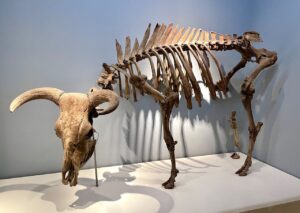Farmwork was one of the most common livlihoods for the Norse, with many people both raising animals and using them for labor.
| “He sat on a grave-mound, striking a harp, Eggther, glad to guard the giants’ herds; close to him, the bright red cock, Fjalar, crowed from the gallows tree.”
Völuspá, 29 |
In the Völuspá, a rooster is described crowing from a tree while an individual keeps an eye on a giant’s livestock herd. |
| “He was among the foremost men in that land. However, he did not have more than twenty head of cattle and twenty sheep and twenty pigs, and the little that he ploughed he ploughed with horses. But their wealth consists mostly of the tax that the Finnas pay them. The tax consists of animal’s skins and of birds’ feathers and whale’s bone.”
Ohthere and Wulfstan, 46 |
Ohthere and Wulfstan and Gylfaginning both describe using horses to plow farm land or haul stone. Besides horses, other animals commonly found on Viking Age farms include cattle, sheep, and pigs, as seen in the quote from Ohthere and Wulfstan. For wild animal consumption, Ohthere and Wulfstan suggests that the Norse hunted in the winter and fished in the summer to optimize animal migration timing and visability. |
| This is an aurochs skeleton from the Roskilde Museum in Denmark that shows a young bull from before the Viking Age, although aurochs existed during the Viking Age in Scandinavia and were domesticated and consumed for meat, as well as their horns used for drinking cups. |
| “As might be expected, in both cases, the youngest animals are more frequent at rural sites, indicating that these settlements were more frequently engaged in animal breeding and raising than were urban centres. The greater number of older animals on rural sites would also equate with animals being kept for breeding, traction, dairying and wool. Urban centres, however, were not completely removed from food production; a small proportion of mandibles from cattle and sheep are from the youngest stages, which may suggest on-site breeding.”
Poole, 150 |
In addition to raising livestock, Viking Age farmers would also breed animals, as evidenced by very young and very old livestock remains being found in rural farm areas of Viking Age Scandinavia, while mid-aged livestock remains were found more often in butcher sites. |
Bately, Janet. “Text and Translation: The Three Parts of the Known World and the Geography of Europe North of the Danube According to Orosius’ Historiae and Its Old English Version.” In Ohthere’s Voyages: A Late 9th-Century Account of Voyages along the Coasts of Norway and Denmark and Its Cultural Context, edited by Janet Bately and Anton Englert, 40–58. Roskilde: Viking Ship Museum, 2007.
Poole, Kristopher. “More than Just Meat: Animals in Viking-Age Towns.” In Everyday Life in Viking-Age Towns: Social Approaches to Towns in England and Ireland, edited by D. M. Hadley and Letty ten Harkel, 144–56. Oxford: Oxbow Books, 2013. (online)
Sturluson, Snorri. “Gylfaginning.” [The Tricking of Gylfi] In Edda, translated by Anthony Faulkes, 7–54. London: J. M. Dent, 1995.
Terry, Patricia, trans. “Völuspá.” In Poems of the Elder Edda, 2nd ed., 1–10. Philadelphia: University of Pennsylvania Press, 1990.
« Previous | Home | Next »
